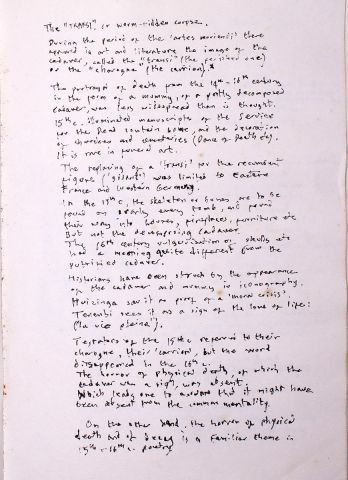Philippe Ariès, Western Attitudes toward Death: From the Middle Ages to the Present, 1974
[Not an exact transcription]
The “TRANSI”, or worm-ridden corpse.
During the period of the ‘artes morienti’ there appeared in art and literature the image of the cadaver, called the “transi” (the perished one) or the “charogne” (the carrion).*
The portrayal of death in the 14th – 16th century in the form of a mummy, of a partly decomposed cadaver, was less widespread than is thought. 15th C illuminated manuscripts of the Service for the Dead contain some decoration of churches and cemeteries (Dance of Death etc). It is rare in funeral art. The replacing of a ‘transi’ for the recumbent figures (‘gisant’) was limited to Eastern France and Western Germany. In the 17th C, the skeleton or bones are to be found on nearly every tomb, and found their way into houses, fireplaces, furniture, etc. But not the decomposing cadaver. The 16th C vulgarisation of skulls etc had a meaning quite different from the putrefied cadaver.
Historians have often been struck by the appearance of the cadaver and mummy in iconography. Huizinga saw it as proof of a ‘moral crisis’. Tenenti sees it as a sign of the love of life: (la vie pleine’).
… Testators of the 15th C referred to their charogne, their ‘carrion’, but the word disappeared in the 16th C. … The horror of physical death, of which the cadaver was a sign, was absent, which leads one to assume that it might have been absent from the common mentality.
On the other hand, the horror of physical death and of decay is a familiar theme in 15th and 16th C poetry. “Sac a fiens” (fientes), “bag of droppings”, said P. de Nesson (1383-1442).









